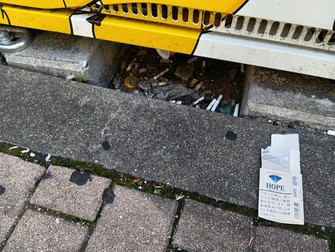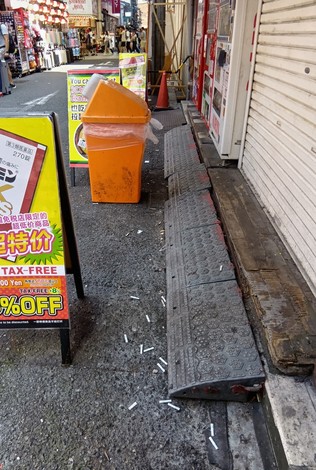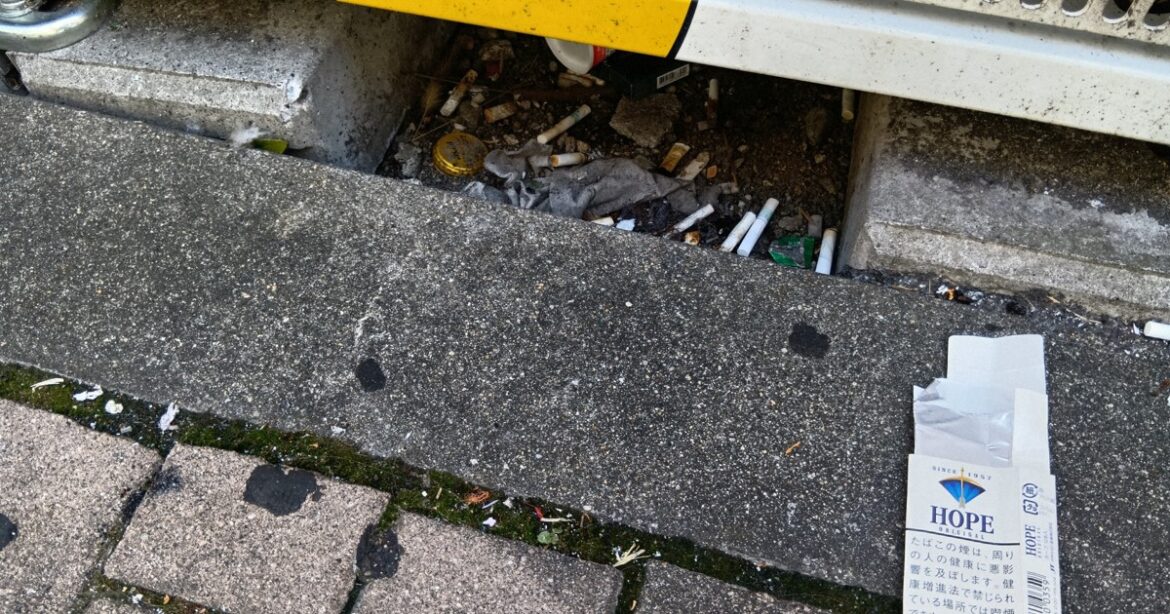
Cigarette butts are seen discarded beneath a vending machine in Osaka’s Chuo Ward on Aug. 18, 2025. (Mainichi/Takuya Suzuki)
OSAKA — A survey counting cigarette butts littered across six locations nationwide found that Osaka’s Namba area was the worst offender by a large margin.
The finding was released by the Osaka Prefecture food service industry sanitation association, which represents about 2,500 restaurant operators. Smoking on streets has been banned in the city of Osaka since January this year, but a shortage of smoking areas in busy districts and other areas has been pointed out, prompting the association to call for stronger measures from authorities.
Namba Station area cigarette litter 4 times higher than around Tokyo Station
The association commissioned Tokyo-based marketing company Spin Inc. to survey six areas including Tokyo and Osaka in June this year. Over one afternoon from 5 p.m. to 9 p.m., two surveyors walked from major stations, counting the number of cigarette butts littered on the streets.
They found the most cigarette butts around the Namba Station area in Osaka’s Chuo Ward, at 4,284. This was over four times the 1,033 butts found in the second worst littered place, around Tenjin Station in Fukuoka’s Chuo Ward. Following were the Tokyo Station area in Tokyo’s Chiyoda Ward with 1,026; the Nagoya Station area in Nagoya’s Nakamura Ward with 699; the Sapporo Station area in Sapporo’s Chuo Ward with 589; and the Umeda Station area in Osaka’s Kita Ward with 365.
Regional characteristics
The Namba Station area, home to tourist spots like Dotonbori and entertainment districts, attracts many inbound tourists. Communicating local rules to visitors from countries where smoking isn’t banned on streets can be challenging. In its analysis, Spin also suggested that the relatively few smoking areas compared to other regions was contributing to a higher incidence of street smoking and littering. One local industry source commented, “Many smoking areas near Namba Station are inside pachinko parlors, which probably makes it harder for those other than customers to use them.”

Discarded cigarette butts are seen in Osaka’s Chuo Ward on Aug. 18, 2025. (Mainichi/Takuya Suzuki)
Nearly 60% witness littering at least once a week
The Osaka Prefecture food service industry sanitation association also commissioned Spin in May to survey the availability of smoking areas in the city of Osaka. The survey targeted 800 residents and commuters (400 smokers and 400 nonsmokers). A total of 66.9% of respondents said that there were not enough smoking areas, with the proportion rising to 87.9% among smokers. A total of 57.9% of respondents reported witnessing cigarette littering at least once a week.
When smokers were asked how they cope when unable to find a smoking area, 73.6% said they “refrain from smoking.” With multiple answers permitted, roughly 20% admitted to “smoking on the street” while around the same proportion admitted to “smoking on private property like coin parking lots.”
Support for smoking ban, with reservations
Why did the association commission the surveys? Minoru Nakamura, the association’s secretary-general, said of the regulations, “I fully support banning street smoking and preventing passive inhalation of cigarette smoke. However, if the authorities can’t fulfill their responsibilities, it would be better not to implement them.”
In January, Osaka expanded its street smoking ban from six specific districts, including around JR Osaka Station and the Ebisubashi-Shinsaibashisuji area, to cover the entire city. Additionally, in April, Osaka Prefecture mandated that indoor smoking be generally prohibited in dining establishments with seating areas exceeding 30 square meters. Both the city and prefectural ordinances impose fines on violators.
The city ordinance states the city has a responsibility to implement “measures necessary to prevent street smoking, such as establishing smoking facilities.” As of June 1, the city had secured around 380 smoking areas, but petitions from restaurant operators and others to increase this number have been submitted to the municipal assembly.
According to the association, with establishments that serve alcohol, in particular, customers shy away when smoking is not allowed inside, putting a financial strain on the businesses. People can smoke inside if a smoking room is installed, but stores need to reduce their seating capacity to secure space to install them. This could lead to financial burdens and decreased revenue.
“We hope the authorities will use the survey results to implement future initiatives,” Nakamura said.
The city is also working on gathering data and plans to release an interim report soon. The aim is to identify high-priority areas for countermeasures and ask companies to establish smoking areas. After assessing the situation following the Osaka Expo, it plans to issue a final report by the end of the year.
(Japanese original by Takuya Suzuki, Osaka City News Department)


AloJapan.com